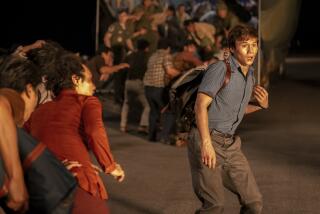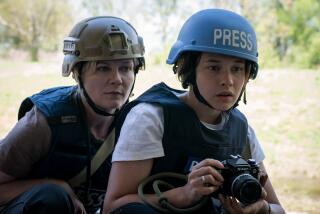The Lowdown on White House Pets
- Share via
A crusty editor once said that a newspaper can’t go wrong with stories about murder or pets.
That might explain the many feature reports early in the Clinton administration about Socks, the first family’s pet cat, and the many stories a year ago about what name the president would give the Clintons’ new dog.
“Dear Socks, Dear Buddy,” written by Hillary Rodham Clinton and published Tuesday by Simon & Schuster, reprints some of the more amusing letters that kids have sent to the four-legged residents of the White House and gives inside dope on the animals that even hard-bitten Washington reporters probably didn’t know.
Buddy “seems happiest snoozing in the sunny window behind the president’s big oak desk made from the timbers of the H.M.S. Resolute,” Mrs. Clinton writes.
“When Buddy and Socks met for the first time, both animals were caught off guard. . . . Intent on protecting his turf, the cat hissed and got ready to spring while Buddy, just as taken aback, barked and strained at his leash. Things got so heated between them that Bill and other peacekeepers had to step in. Concerned allies set up several summits in an effort to broker a truce between the pets. It wasn’t until the day that Socks swatted Buddy on the nose and sent the puppy off yelping, though, that they began to get along fine.”
Sam Bradman, one of the young letter writers, asks: “How do you like being a dog, Buddy? I like being a person.”
From Ross Rankin to Socks: “Are you allowed to watch MTV?”
In Mrs. Clinton’s 1996 best-seller, “It Takes a Village,” she focused on the needs of children and ways to improve family and community life. In “Dear Socks, Dear Buddy,” besides answering questions about the Clintons’ pets and offering a nicely illustrated history of other pets in the White House, the first lady gives advice on animal care and tips for parents on how to help children express themselves through writing.
Simon & Schuster has introduced “Dear Socks, Dear Buddy” with a big first printing of more than 400,000 copies. The copyright is held by the National Park Foundation, which will receive all author earnings from book sales and ancillary sources, such as book clubs and the purchase of excerpts by magazines.
The publisher said there were no immediate plans for Mrs. Clinton to make promotional appearances.
Vietnam on Deadline
Each of the panelists at the Media Studies Center in New York last week first read a portion of their work included in “Reporting Vietnam,” a two-volume collection newly published by the Library of America.
Frances FitzGerald dipped into a piece she wrote for Vogue 32 years ago, describing a victorious South Vietnamese general in his high-ceilinged villa as “he calls for the servants to bring coffee and hot towels and waves across at his wife and her retinue of women who stand at the foot of the grand staircase waiting to join the party.”
Among the other panelists, Kevin Buckley, now the executive editor of Playboy, reprised one of his dispatches for Newsweek, dated 1968 and describing a firefight near Loc Ninh: “There were four enemy dead--all disfigured with gaping wounds.” Stripping them of their gear, the men of Alpha Company “placed ‘Big Red One’ shoulder patches on each dead face” so those to follow would know which soldiers had been there.”
Sydney H. Schanberg, the former Newsday columnist, read from one of his memorable stories on the fall of Phnom Penh in 1975 that he reported for the New York Times and that earned him a Pulitzer Prize. Although Schanberg’s decision to remain in the Cambodian city through its capture by the Communist Khmer Rouge has been popularized in the harrowing movie “The Killing Fields,” the journalist’s original words on newsprint recall for me the riveting experience of reading his reports for the first time.
Schanberg described the chaos and heartache from a world away as the Khmer Rouge began their “peasant revolution” by forcing every soul out of Phnom Penh and deep into the countryside. As he read again last week, the evacuated were “covering the roads like a human carpet . . . dispirited and frightened by the unknown that awaited them and many plainly terrified because they were soft city people and were sure the trip would kill them.”
History, of course, showed that the trip and subsequent brutality killed millions. But Schanberg and his colleagues were writing only news, what former Washington Post Publisher Philip Graham called “the first rough draft of history.”
Rough drafts written by more than 80 journalists between 1959 and 1975 make up “Reporting Vietnam.” The second of the hardcover volumes, which covers 1969 to 1975, also contains the complete text of Michael Herr’s book “Dispatches.”
“At the mud and blood level, there was considerable affection” between American troops and the reporters who covered them, Buckley recalled. At the same time, panelists remembered that it was sometimes difficult getting certain observations from the field past their editors back in the U.S.
“In Cambodia, your desk in New York couldn’t reach you,” Schanberg said. “It was glorious.”
Paul Colford’s e-mail address is P[email protected].
More to Read
Sign up for Essential California
The most important California stories and recommendations in your inbox every morning.
You may occasionally receive promotional content from the Los Angeles Times.










